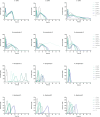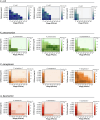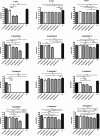In vitro activity of cefiderocol against Gram-negative aerobic bacilli in planktonic and biofilm form-alone and in combination with bacteriophages
- PMID: 40379736
- PMCID: PMC12084636
- DOI: 10.1038/s41598-025-01704-w
In vitro activity of cefiderocol against Gram-negative aerobic bacilli in planktonic and biofilm form-alone and in combination with bacteriophages
Abstract
Multi-drug resistant Gram-negative pathogens are increasingly difficult-to-treat perpetrators of infections. New, innovative, and more multifaceted therapies for the treatment of multi-drug resistant strains are thus urgent to hinder further drug resistance and mitigate deadly, untreatable infections. Our study aimed to investigate the efficacy of cefiderocol against Gram-negative aerobic bacteria alone and in combination with phages. The minimum inhibitory concentration (MIC) of cefiderocol was determined using the microdilution broth method, while the minimum biofilm bactericidal concentration was assessed using isothermal microcalorimetry. The combined effect of cefiderocol and phages was evaluated using colony-forming unit counts. Results demonstrated a notable antibacterial effect of cefiderocol, with 83.4% of tested strains exhibiting susceptibility. When combined with phages, the MIC of cefiderocol was reduced by 2-64-fold, indicating a synergistic interaction between the two agents. Furthermore, the combination therapy showed enhanced efficacy against biofilm compared to monotherapy with either cefiderocol or phages alone, leading to complete biofilm elimination in certain cases. This study highlights the potential of combining cefiderocol with phages as a strategy to combat multi-drug resistant Gram-negative bacterial infections. The observed synergy suggests that this combination therapy could improve treatment outcomes and help address the challenges of antibiotic resistance and biofilm-associated infections.
Keywords: Anti-biofilm activity; Cefiderocol; Multi-drug resistant pathogens; Phages.
© 2025. The Author(s).
Conflict of interest statement
Declarations. Competing interests: The authors declare no competing interests.
Figures



Similar articles
-
Cefiderocol: A Siderophore Cephalosporin with Activity Against Carbapenem-Resistant and Multidrug-Resistant Gram-Negative Bacilli.Drugs. 2019 Feb;79(3):271-289. doi: 10.1007/s40265-019-1055-2. Drugs. 2019. PMID: 30712199 Review.
-
Cefiderocol Retains Antibiofilm Activity in Multidrug-Resistant Gram-Negative Pathogens.Antimicrob Agents Chemother. 2021 Jan 20;65(2):e01194-20. doi: 10.1128/AAC.01194-20. Print 2021 Jan 20. Antimicrob Agents Chemother. 2021. PMID: 33199383 Free PMC article.
-
In Vitro Activity of Cefiderocol against U.S. and European Gram-Negative Clinical Isolates Collected in 2020 as Part of the SENTRY Antimicrobial Surveillance Program.Microbiol Spectr. 2022 Apr 27;10(2):e0271221. doi: 10.1128/spectrum.02712-21. Epub 2022 Mar 9. Microbiol Spectr. 2022. PMID: 35262394 Free PMC article.
-
Evaluation of antibiofilm activity of cefiderocol alone and in combination with imipenem against Pseudomonas aeruginosa.J Glob Antimicrob Resist. 2024 Jun;37:53-61. doi: 10.1016/j.jgar.2024.01.021. Epub 2024 Feb 6. J Glob Antimicrob Resist. 2024. PMID: 38331031
-
[Cefiderocol: a first and novel class of siderophore cephalosporin for Carbapenem-resistant Gram-negative infection].Nihon Yakurigaku Zasshi. 2024;159(5):331-340. doi: 10.1254/fpj.24029. Nihon Yakurigaku Zasshi. 2024. PMID: 39218681 Review. Japanese.
References
-
- Corcione, S. et al. Cefiderocol use in gram negative infections with limited therapeutic options: Is combination therapy the key? J. Infect. Public Health15(9), 975–979 (2022). - PubMed
MeSH terms
Substances
LinkOut - more resources
Full Text Sources
Medical

